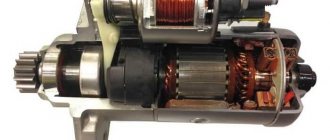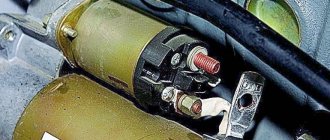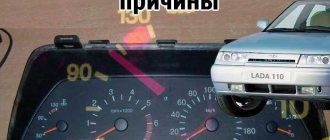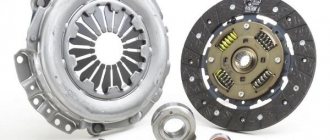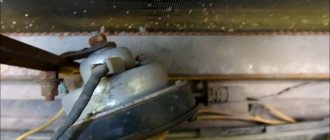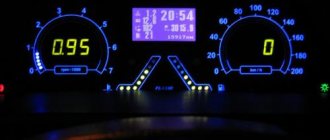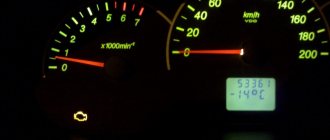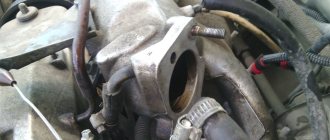A car starter is one of the important parts of a car's attachments. It is he who rotates the crankshaft of the engine, giving it the speed necessary to start. The starter on the VAZ 2114 operates on direct current and is powered by a battery. This part was inherited from the VAZ 2114 by its predecessor, the VAZ 2109, but received a few modifications, since the 14th model has been produced since 2000, it already had a gear starter installed that could rotate the crankshaft with less force and less current consumption.
Often, owners of 2114 are faced with the problem of starting the car engine, which is caused by a breakdown of the starter.
This article talks about the starter of the VAZ 2114 car, namely its design, signs of malfunction, causes of failure, cost, self-replacement and repair.
Purpose
A starter is an electrical device that converts electrical energy into mechanical energy. The mechanical energy received from the starter is directed to rotate the crankshaft through the flywheel crown, thereby delivering the crankshaft speed necessary to start the engine. The starter receives power only from the battery and uses its energy only when the engine starts. When the engine starts, the starter does not consume any energy from the vehicle's on-board network. It is a kind of DC electric machine designed only to start the motor.
How to eliminate the causes of problems starting the car engine
Buying a new starter is not always justified. The old unit can serve for a long time. It is enough to carry out qualified diagnostics and replace faulty internal parts: bushings, brushes.
If it is not possible to deliver a faulty car to a service station, then it is necessary to remove the faulty part and take it to a mechanic. Only qualified diagnostics using special equipment can identify the exact fault. Repairing internal parts is much cheaper than buying a new part.
Usually repairs do not take much time. It all depends on the workload of the repairman and the availability of the necessary spare parts. It is better to contact a service that specializes in repairing electrical equipment for cars. If circumstances are favorable, you will be able to get behind the wheel of your car the very next day.
Design
A car starter consists of many parts necessary for its operation. Its main parts are the rotor, stator and brush assembly. These parts are necessary to rotate the starter shaft, which engages with the ring. There is also a special electromagnetic relay on the starter that works to retract the armature. It is this that engages the bendix armature with the flywheel crown.
Adviсe
Only proper operation of the car will extend the service life of the starter:
- If all other components and parts of the mechanism are in working order, hold the ignition key for no more than 15 seconds.
- Do not rush to turn on the ignition earlier than 30 seconds so that the fuel pump pumps fuel and creates the necessary pressure.
- Install the starter in place without distortion, securely fasten it.
Take into account the summer active evaporation of electrolyte from battery cans, promptly bringing it to the required density.
Signs of a faulty starter
There are several signs of a starter malfunction, by which you can judge what exactly is the cause of the breakdown and then fix it.
- When trying to start, the starter clicks but does not turn;
- When trying to start, the starter does not show any signs of “life”;
- When you try to start, the starter buzzes, but the engine does not rotate;
- When trying to start, the starter barely turns the engine;
- After starting the engine, an extraneous knocking and grinding noise is heard;
If such malfunctions appear on your car when using the starter, the starter requires replacement or repair.
Let's look at each of the faults in more detail.
The starter clicks but doesn't turn over
If such a problem occurs, there may be several reasons, the first thing you need to do is:
Check the condition of the terminals on the battery. Quite often, these terminals become oxidized, which makes the contact worse and, therefore, the starter does not have enough current to start the engine.
Check battery charging. Such symptoms are possible when the battery is completely discharged; this happens quite often in cold weather or after the car has been idle for a long time with the lights on.
Also, one of the reasons may be jamming of the starter shaft in the bushing; this happens after a long period of inactivity of the car.
The starter shows no signs of “life”
When the starter is completely silent, this may be the cause of a breakdown not of the starter itself, but of the starter control circuit. For example, the ignition switch may be faulty or the battery may be completely discharged, and there may also be faults in the starter power circuit (missing ground or plus).
In other cases, the starter should make at least some sounds
The starter hums, but does not turn the engine
When this problem occurs, the culprit is most often the starter solenoid relay. It fails, thereby not moving the bendix towards the flywheel, because of this the starter cannot engage with the flywheel crown.
If this problem occurs, it is necessary to change the starter solenoid relay.
The starter barely turns the engine
This problem may lie behind:
- In a weak battery;
- Poor contact on the starter marks;
- In the interturn closure of the starter;
If the starter on your car turns the engine weakly, first of all you need to inspect the battery, check its charge, and then stretch the contacts on the starter and battery terminals. If this does not help, then you need to have the starter repaired or replaced with a new one.
Knocking and grinding
If there is a knocking or grinding noise when the starter is operating, there is most likely a problem with the starter gearbox, its gears, or the flywheel ring is worn out. The problem with the breakage of the starter gear is solved by replacing the mechanism, but if the flywheel ring wears out, it is necessary to carry out a rather complex repair, which will require removing the gearbox, as well as the clutch and the flywheel itself.
Conclusion
Grinding and crackling noises in the power unit indicate that some engine parts have failed. So, the grinding noise is accompanied by a malfunction in the starter or flywheel. As for the crackling sound, the situation is much more complicated - most likely the problem is hidden in the crank mechanism or in the cylinder head.
If such malfunctions occur, it is recommended to contact a car service as soon as possible, so as not to cause more trouble than already exists.
Source
Starter control circuit failure
Quite often, the starter may fail to operate due to breakdowns in the starter power supply circuit, namely, parts such as a relay, fuse, ignition switch, etc. may fail.
What can affect the starter's performance:
- Intermediate relay;
- Fuse;
- Egnition lock;
VAZ 21099 carburetor does not start List of popular reasons and repair methods
Where is the Charging Relay on the UAZ Bukhanka. UAZ charging relay
- There is no voltage from the battery to the starter;
- Check the indicator on the battery; it should light green.
- If it is black or red, it means the charge is very low and you need to recharge the battery. 20-25 minutes are enough to start the engine;
- The degree of wear of the graphite rod on the distributor of the trampler has exceeded the permissible standards, as a result of which current does not flow to the first cylinder and the mixture cannot ignite;
- We unscrew the cover of the distributor and look at the rod, it is centered inside. The minimum length should be 1.0 cm or more, if less, replace the tamper cover. Due to the fact that the graphite rod does not reach the distributor, the current is not transmitted to the spark plugs and, accordingly, there is no ignition.
- The throttle valve is closed and air does not enter the working chambers of the carburetor;
- Check the tension of the choke cable. The air damper rod must be strictly vertical; all other positions may overlap it and become a barrier to air. Press out the bolt and straighten the rod.
- The fine filter of the fuel system is very dirty and does not allow gasoline to pass into the combustion chamber in the required quantity;
- Look at the filter color. If it is a rough orange color, it needs to be changed because it is clogged. The optimal color is light yellow.
- The coil on the ignition coil is damaged, causing the spark plugs to not receive the spark that is the source of ignition. See the article “How to test the ignition coil with a multimeter”;
- Proceed as follows: disconnect the positive cable on the battery, unscrew the top part of the ceramic block on the coil and you will see a metal spiral. If there is damage, the entire ceramic module must be replaced. There are no other options. It is strictly forbidden to use soldering, it will not help.
- The fuel and/or air jets are clogged and cannot transfer the mixture to the combustion chamber;
- You can only check by unscrewing the air filter cover and removing it along with the top carburetor cover. After unscrewing both types of jets, blow them with a stream of compressed air and screw them back in. There is no need to change.
- The line of the electrical cable that transmits current through the circuit is damaged;
- If you are not an electrician, then it will be difficult for you to determine which wire is damaged. Try only with the tester, starting from the ignition switch;
- There is no gasoline in the gas tank (for example, it was drained);
- The diaphragm in the fuel pump does not work or is damaged (see signs of a faulty fuel pump);
- Only by removing the top cover of the fuel pump can you understand the degree of integrity of the diaphragm. Replace if damaged.
- The cam on the fuel pump rod is damaged or severely worn, as a result of which the rocker rod does not touch it and fuel is not pumped into the system;
- In this case, it is necessary to change only the entire fuel pump as a whole. Once a cam wears out, it cannot be repaired.
- The air filter is clogged;
- The cylinder head is broken, and as a result, the compression level has dropped sharply and is not enough to ignite the mixture.
Removing the starter
Replacing the starter on a VAZ 2114 is quite simple; you just need to prepare the tools necessary for replacement.
To replace you will need:
- Sockets and ratchet;
- Open-end wrenches;
After which you can begin to remove the starter from the car.
- Remove the negative terminal from the battery;
- Unscrew the suitable wires to the starter;
- Remove the connector from the solenoid relay;
- Unscrew the bolts securing the starter to the gearbox housing;
- We take out the starter;
- We assemble in the reverse order;
The battery is low
The vehicle's power supply system largely depends on the health of the battery. To keep it in working order, you must comply with a number of requirements and instructions. If, for some reason, the battery was not taken care of, then sooner or later such negligent attitude will come back to haunt the owner.
The most pronounced symptoms of a faulty battery are:
- low brightness of running lights;
- sound signal attenuation;
- presence of a red/white indicator on the battery cover;
- deflection of the on-board ammeter needle towards the charge when the starter circuit is closed;
- presence of sulfation at the battery terminals.
All these signs, one way or another, indicate that the battery needs diagnostics. First, you should check the level and density of the electrolyte. After this, the battery must be charged using a charger. If the battery is old, charging should be done at extremely low charging current values.
During this procedure, the battery can caps must be removed. During the entire charging time, you must ensure that the battery does not self-discharge. It happens that during charging one or more cans begin to “boil” before the rest. This phenomenon indicates that the battery, due to improper care, has exhausted its resource.
Diagnostics
The first step is to determine the source of the sound. You can do this yourself, but in this case you need to clearly know the characteristic sounds of each mechanism. The easiest way is to ask a friend to start the car, listen for yourself and determine the source.
In 99% of cases, the malfunction lies in such elements of the engine compartment as:
3) GUR.,
Bearings creaking
Typically, various bearings travel 100,000 km or more. However, over time, the lubricant inside them runs out and the elements begin to rub, producing a creaking sound. Such bearings do not work for a long time. In winter, this is aggravated by the loss of the lubricating properties of the filler.
Whistling belts
Seat belt squealing is the most common cause of the above. This is due to their wear and temperature changes. Some manufacturers of spare parts make drive belts from low-quality rubber and quickly gather dust in the cold.
Power steering
If he whistles for 3-4 seconds and then goes silent, this is normal. In cold weather, the technical fluid also loses its fluidity, so the pump operates with overload for some time. However, if the power steering fails, you should not do it yourself, as it is a very complex mechanism.
On our website you will find:
- reviews of the most common problems encountered by machines.
- statistics on sales and position of the Russian automotive industry in both local and international markets;
- current information about Lada, new products and brand news;
- all the most important information that will help you when repairing VAZ cars;
- useful tips on operation, repair and maintenance of VAZ cars;
If you have any questions about repairing your car, materials and spare parts, you can get advice from a specialist. To do this, go to the CONTACTS section and send your question. This and much more about the characteristics of domestic cars can be found on our portal OLADE.RU
Cracking on a cold engine: twin-shaft timing and variable valve timing system
Let's start with the fact that many modern engines are quite powerful with a relatively modest displacement.
This became possible not only thanks to the installation of turbochargers and other similar solutions to boost the internal combustion engine, but also due to the integration of two camshafts into the timing belt, an increase in the number of valves per cylinder, and the active use of variable valve timing systems.
As a result, even naturally aspirated engines with similar solutions have become much more powerful, stable and responsive over a wide rev range. However, owners of such engines often notice from 70-120 thousand km that when starting the engine from cold, a wheezing sound is heard, which disappears after 5-10 seconds. If the engine warms up even a little, there will be no suspicious noises until the next cold start.
So, the culprit of the problem could be the variable valve timing system, which is called VVT-I Toyota, i-VTEC Honda, MIVEC Mitsubishi, VANOS BMW, etc. From different manufacturers. Manufacturers are structurally different. Moreover, the presence of this system does not mean that it is the one causing the problems, but there have been cases when it was the problem.
For example, owners of a Honda Accord with a K24 twin-shaft engine are faced with the problem of rattling in the cold precisely because of problems with the i-VTEC system. Let us dwell on this in more detail, since similar problems often occur with other car manufacturers.
Simply put, i-VTEC is a continuation of the well-known VTEC system with the prefix "i" indicating that Honda has made the camshaft control system smarter. If the simple initial VTEC worked only from special cams on the camshaft, and the valve lift was adjusted without the use of other devices, then in the case of the i-VTEC system it became possible to change the phases in all operating modes of the internal combustion engine.
As a result, fuel consumption decreased at low speeds, and power and throttle response noticeably increased at high speeds. In addition, the valve timing began to switch smoothly and imperceptibly milk the driver. The only drawback is that the system itself has become more complicated.
We also recommend reading the article on how to determine what is knocking in the engine. From this article you will learn about the causes of knocking and how to identify a particular problem.
Let's move on. Flexibility in changing phases made it possible to install a special device on the intake camshaft, known as a VTC phase regulator. In fact, the solution is a kind of split transmission that can set the phase shift not constantly, but dynamically, in real time. This is made possible by the fact that VTC operates based on engine oil pressure.
It turns out that the lower the pressure in the oil system and the lower the engine speed, the more the phases shift, taking into account the lean mixture. However, as soon as the driver presses the accelerator pedal, the gear shifts relative to the shaft in the direction of increasing fuel supply. The result is better cylinder filling and a noticeable increase in power.
Please note that it is the VTC that eventually begins to make a cracking sound when starting from cold. The problem lies in the design of this gear, so to speak. The solution inside is hollow, and the engine oil moves into this cavity. There is also a mechanical fixation of the gear on the shaft.
This clamp allows you to secure the gear to the shaft in the absence of oil pressure. In other words, if there is pressure, it presses the gear, if not, then the fastening is carried out by a latch. At the same time, during operation, this retainer becomes clogged with various contaminants present in the engine oil, namely, coke retainer.
In this case, the latch cannot function normally, and the crackling sound heard after startup is an attempt by the coke latch to return to its place. This crackling noise is heard in the engine until the gear is set by oil pressure. In practice, you can try to clean the gear from dirt, but often the cracking noise appears again after a while. The fact is that the retainer is usually already worn out, so it is optimal to immediately replace the entire part.
